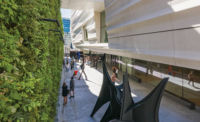It wasn’t long ago that green design was a novelty or an experiment done on guinea-pig projects. But that was then and this is now.
“Today everybody’s doing it,” says Steven Spaid, with San Francisco-based SmithGroup.
“But less than five years ago you really had to sell the client on investing in green because it cost more.”
As you can see in the following rankings of the Top Green Designers of 2010, architectural and engineering firms are moving steadily into the sustainability world with impressive number of LEED-accredited professionals being added to their teams, bigger green revenues and higher-profile green projects breaking ground.
Meanwhile, Spaid, who is a principal on the proposed new $1.7-billion Cathedral Hill Hospital project at Van Ness and Geary streets in downtown San Francisco, says the extra costs of sustainable design are “phasing out” as the industry moves forward and becomes increasingly green.
Mara L. Baum, associate with San Francisco-based Anshen + Allen, a part of Stantec, agrees.
“The building community is beginning to realize some of the larger value of green design both from an economic standpoint over the life of the building and also from the standpoint of human health and the impact of that on the performance of the building,” she says.
Baum, who is sustainability coordinator on the new $300-million Santa Clara Valley Medical Center, says green design is also gaining momentum in the slow economy because greater attention is currently being paid to the value of sustainable resources over the long term.
“I think as more green buildings come on line, we are going to see data to support why these buildings are better, and how they are going above and beyond what was traditionally built,” says Patrick McClintock, with Irvine-based LPA Inc.
McClintock is serving as LEED interior designer for the $66-million College Center project at the College of San Mateo, which is gunning for LEED gold.
Both healthcare facilities are also shooting for LEED ratings: The 555-bed hospital in San Francisco is aiming for silver and Santa Clara is going for gold.
To be built by the joint venture of Herrero Boldt of San Francisco, the Cathedral Hill hospital is scheduled to break ground in January and with completion in 2015. The facility is currently in the entitlements and approval stage.
The project consists of the 1.2 million-sq-ft main hospital and a 496,000-sq-ft medical office building, being built by Pasadena-based Pankow.
Designed with a modern metal panel and glass exterior, the 15-story hospital will be blue and tan on the outside, but green on the inside.
“The most evident LEED feature is a green vegetative roof on the lower levels of the hospital which covers about 25% of roofing,” says Spaid. “Green roofs are workhorses; they treat and reduce the quantity of storm water runoff because the water is absorbed by plant materials and then trickles through the soil slowly and this delays the water from entering the sewer.”
He says in conjunction with the green roofs, the facility has a series of cisterns under the building that can store up to 100,000 gallons of water, which can be used to irrigate the roofs during the dry months.
He says the roofs also reduce energy by acting as sun barriers and provide therapeutic views for patients.







Post a comment to this article
Report Abusive Comment